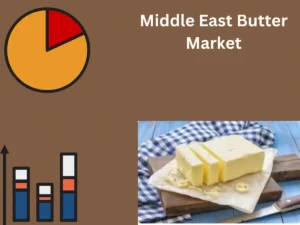© 2024 All rights reserved
Datavagyanik- Your Research Partner

The Middle East’s butter market is expected to experience a surge in demand in the coming years. This trend is being fueled by many variables, such as shifting consumer preferences, expanding populations, and rising prosperity in the area.

First off, Middle Eastern customers are becoming more and more interested in cuisines and ingredients that are inspired by the West. As a result, butter, a component of many Western diets, has gained popularity in the area. Butter is a great source of important vitamins and minerals, and there is also growing recognition of its health advantages.
Secondly, the population of the Middle East is growing rapidly, with estimates suggesting that the region’s population could double by 2050. As a result, there will be an increasing demand for food and ingredients, including butter, to feed the growing population.
Thirdly, there is rising affluence in the Middle East, with more people able to afford a wider range of food products. As incomes rise, so does the demand for premium products, including high-quality butter.
The United Arab Emirates is the largest importer of butter in the Middle East, accounting for 39% of the total market share.
Saudi Arabia is the second largest importer of butter in the Middle East, with a market share of 15%..
The top five countries in the region that produce butter are Saudi Arabia, Iran, Turkey, Egypt and Iraq.
Butter is a popular ingredient in many traditional Middle Eastern dishes such as kibbeh and baklava.
Saudi Arabia is the largest consumer of butter in the Middle East followed by UAE, and Turkey, accounting for more than 40% of the total market share in 2019.
Finally, with increased investment in dairy farms and processing infrastructure, the Middle East’s dairy industry is also growing. As a result, there should be more premium butter available in the area, which will raise demand.
Overall, it is anticipated that there will be a large increase in demand for butter in the Middle East over the next several years due to a mix of shifting consumer preferences, population growth, rising wealth, and expanding dairy industry.
Butter is a dairy product formed from milk or cream that has been churned until the butterfat solidifies and the buttermilk liquidises. It is a multipurpose ingredient that can be used for baking, cooking, and spreading.
Both salted and unsalted cream can be used to make butter. Salted butter has additional salt, often 1% to 2% by weight, to improve flavour and preserve butter. Contrarily, unsalted butter has no salt added and is favoured by some bakers and chefs as it enables them to regulate the amount of salt in their recipes.
The industrial processing of butter involves several steps. First, a centrifugal separator is used to separate the fat from the milk or cream. The cream is next churned to separate the fat from the liquid after being pasteurised, which eliminates any unwanted microorganisms. Following a water wash to eliminate any remaining buttermilk that would ruin the butter, if desired, it is salted. After that, the finished product is packed and distributed to food services and retail outlets.
Several retail outlets, including supermarkets, grocers, and speciality food stores, carry butter. It is frequently marketed in salted and unsalted varieties and can be purchased as blocks, sticks, or tubs. Butter is frequently utilised in food service, including restaurants, cafes, and bakeries, in addition to retail channels.
In food service, butter is used in a wide range of dishes, from pastries and bread to sauces and soups. It is often used as a cooking ingredient to add richness and depth of flavour to dishes. Additionally, it is commonly used as a spread for bread and other baked goods.
Overall, butter is a versatile and essential ingredient in the food industry. It is available in both salted and unsalted varieties and is processed through several steps in the dairy industry before being distributed to retail channels and food services.
The Butter market in Saudi Arabia is growing due to the increasing demand for dairy products in the country. Saudi Arabia’s population is expanding quickly, which is also driving up demand for dairy products. Also, the government has made significant investments in the dairy sector by giving farmers and producers incentives and subsidies to boost output. As a result, butter is now more readily available on the market, which has raised consumer demand for it.
The Butter market in the UAE is also growing due to several factors. Firstly, there is an increasing demand for dairy products from both local consumers and tourists visiting the country. Secondly, many initiatives are being taken by the government to promote healthy eating habits among its citizens. This includes providing subsidies and incentives for producers and encouraging people to consume more dairy products. Finally, several international companies have set up operations in the UAE, which has further increased the availability of butter in the market.
The middle east butter market has been segmented into Types and End-Use.
Based on the Types, the middle east has a butter market for Salted and Unsalted. In 2021, the salted-based segment held a significant share. Salted butter is a type of butter that has salt granules added to it for flavour and preservation. This is because consumers are increasingly looking for food products that offer convenience and are easy to use. Salted butter is convenient and does not require the user to add any extra seasoning, making it a popular choice among consumers. For instance, the demand for salted butter has been growing due to its convenience and its ability to enhance flavour without additional effort. It is one of the most popular types of butter and is used in a variety of recipes, from baking to cooking to spreading on toast.
Based on End-Use, the market is classified as Industrial Processing, Retail Channels, and Foodservice. In 2021, the segment is expected to account for a significant share of industrial processing. This is due to the growing demand for automation and digital transformation in the industrial sector. The increasing adoption of advanced technologies such as artificial intelligence and machine learning is also expected to boost the growth of this segment. This is because these technologies allow for the automation of many processes and improve the efficiency of operations. Additionally, the use of digital transformation technologies such as cloud computing, the internet of things, and blockchain is expected to reduce the cost of operations and increase the accuracy of data.
By Type
By End-Use
By Region
“Every Organization is different and so are their requirements”- Datavagyanik







© 2024 All rights reserved
Datavagyanik- Your Research Partner
Add the power of Impeccable research, become a DV client